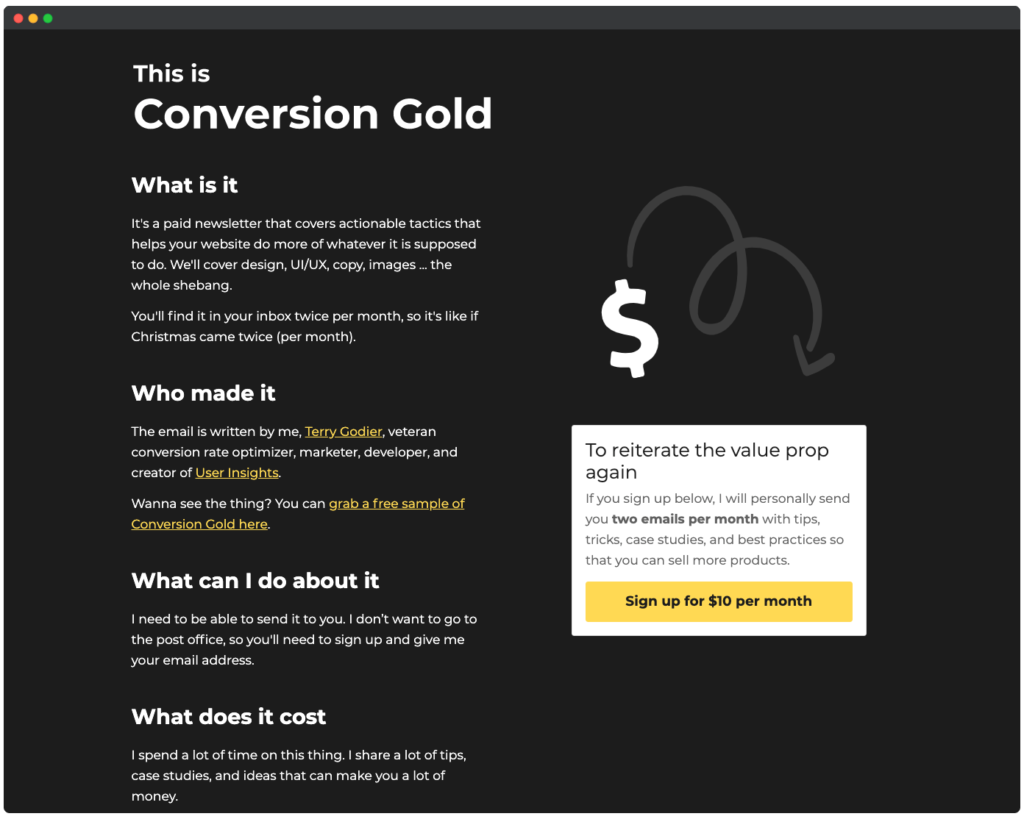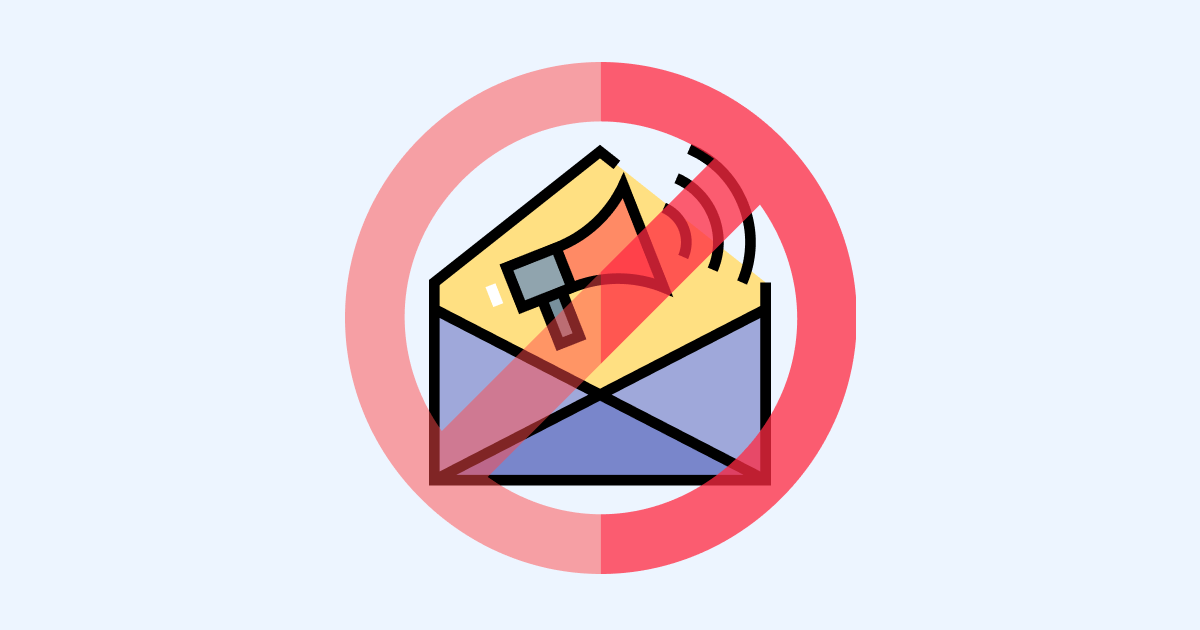I launched a paid newsletter in October 2019, quickly racked up thousands of subscribers, and then took 18 months to run it into the ground.
This is my cautionary tale, told in four parts.
Part 1: Conversion Gold
It all started, as almost nothing good does, in a hotel room in southern Florida. It was October of 2019, and I had recently left my long-term SEO gig at CBS Interactive (now ViacomCBS).
I had been running a side project called User Insights, which was a remote user testing platform. I was passionate about CRO (conversion rate optimization), and the insights you could get from watching real users do real things on real websites were outstanding.
The problem was that most people only got to see what people did on one website — but I could see them all. I knew some common issues existed across many widely used design patterns. The problem was that many testing projects wouldn’t surface these issues.
I had spent the past several years working with editorial teams and had closely watched the nascent paid newsletter industry begin to grow. Major publishers were shedding editorial staff, and many top writers were launching paid newsletters to what seemed like a great success.
I saw it as a compelling business model: where someone with something to say could get paid to say it without having a boss.
I decided that what I’d do is take all of those insights I was accruing from running User Insights and send them out in a paid newsletter a couple of times a month. The pitch was simple: for $10 per month (less than the cost of 1 user test), I’d send you an email with everything I knew about making better websites.
I built the now “infamous” (in a relative way) landing page and sent an email to all User Insights users.
Here’s what it looked like:

Then I did what smart marketers do, and I told my friends about it. Several were really good friends and either tweeted it or shared it in their personal newsletters.
I gave each of them 50% off coupons to share, so the vast majority of sales rolled in at $5 per month (or $50 per year, annual plans).
The first few issues were very well received. I was happy to write them and my subscribers seemed genuinely happy to receive them.
I had an opt-in form that sent a free sample — and a quick teaser of each issue would go out to those people to get them to sign up. It worked very well. Each month Conversion Gold grew by double-digit percentage points.
It was the best of times, it was the worst of times.
Then I destroyed it.
Part 2: Panoply
Those who know me know that I have a hard time standing still. I am utterly awesome at coming up with ideas and launching new projects.
The problem is that I get bored quickly and move onto the next shiny thing. I don’t think that I’m alone here, but I’m certainly the only one in my friend group that does this. It’s embarrassing.
Part of the promise of doing Conversion Gold was that it was supposed to be a long term project. I love writing about websites and marketing, and I certainly love getting paid.
I found out that loving writing about websites doesn’t mean that you’ll love sitting down to do it twice a month for the rest of your life.
I didn’t want to pigeonhole myself. My ideas were bigger than that. I had spent the past 15 years developing a particular set of internet skills, and it felt like a shame not to use them. I wanted to make courses, videos, apps, podcasts, and more than anything: I wanted to write more than Conversion Gold.
So, I did what I do, and tried to make it so.
In March of 2020, I gave all subscribers of Conversion Gold a pro-rated refund and canceled their subscriptions. Several friends advised me not to do this… but I felt sure that my readers would come back, especially since I had proven myself trustworthy and given them upfront refunds.
I went dark, quietly working on my next big thing. In the background, Covid19 raged. Quarantining gave me more cover to go deep and work on something truly meaningful.
It was called Panoply, which is an uncommon old word that means “a box full of wonderful things,” which is precisely what I intended to build.
On April 15, 2020, I launched a snazzy new website, hand-designed and hand-coded. All of the old Conversion Gold content was there, in addition to a video course on spaced repetition and several podcast episodes (one with former poker player Annie Duke).
I felt great. This was it — this was the project that could end all projects for me. I could put anything I wanted into the Panoply box, and it would fit and make sense.
I sent out an email and left the computer for the day, planning to turn my phone on DND because of the anticipated swell of payment notifications.
Except they never came.
On that first day of the launch, I sent an email to thousands of former subscribers, people who had been paying me money for content about a month earlier. Grand sales total? Two. I sold two subscriptions.
I scrambled. The messaging was all wrong. It wasn’t clear what people were buying, and more importantly, it wasn’t clear why it was valuable. I fell victim to the same fate as many product builders who build passion projects: I was unable to see it as my customers saw it.
I had a roundtable with several friends, re-worked the value proposition, re-wrote my about me page, and changed the pricing.
Slowly, but surely sales grew. Between April 15 and September 2020, Panoply grew to about 100 members. Not bad, but still a far cry from Conversion Gold.
I produced some of my favorite things while working on Panoply. I love that spaced repetition course, and I love the presentation I gave at a virtual conference: How to Stop Being a Dumb Marketer.
Anyway, it was time for a pivot. Tuning the messaging on Panoply to point more towards marketing advice was what helped grow the subscriber base. I figured I’d double down and figure out a way to finagle some consulting, as well.
Part 3: Growth Library
I’ve been writing about marketing online for a long time. I’ve seen firsthand how content can be your best sales asset for consulting gigs.
I came up with a model that was compelling to me. I’d build out a company called Growth Library, which would be a hybrid, content-first agency.
I’d produce premium marketing content (for subscribers), and then each piece would include a “need help implementing this advice?” CTA, which would allow people to book a call with me.
The idea was that I would publish a piece of strategic marketing content, and that would drum up a handful of consulting calls each month from people wanting help implementing the ideas. All of my clients would become subscribers, and all of my subscribers would eventually become clients.
The linchpin was a content type I called Marketing Patterns.
I’m a pretty organized person, and I love doing research, so the way I do marketing is by building out specs. I dig in, take notes, and then build out a document that holds the entirety of the insight, strategy, and analysis for the program.
Marketing Patterns are spec documents but without a specific product. They’re written to be more general and applicable to anyone with a little bit of thinking. As the landing page says, they’re DIY templates for growth.
This was the killer content type. The idea was that these would be useful for marketers to keep up to date and generate campaign ideas and hopefully expose them to new concepts, which they’d pay for a strategy call or two to help get going.
To make a long story short, it worked. I got consulting calls, and people paid to get access to the library of marketing patterns.
But it didn’t feel right. My site traffic was very low, and I had no real discovery flywheels at all. All of the good stuff was behind a paywall, and due to other commitments, I didn’t have enough time to make great free content. I felt like I was running uphill through sand, and I began to feel like I wasn’t delivering enough value to my paid subscribers.
Slowly, over the course of a few months, that peculiar dread came back. Every paid newsletter creator that I’ve met has mentioned it. It’s the low-level anxiety of selling your future time and having to deliver value in perpetuity, never knowing if you’re doing enough.
What I wanted, at the core of it all, was an audience. Conversion Gold felt like an audience, and it was cool that it was private because it kept the gawkers out. But was that only because it was premium, or was it the type of subscriber it attracted?
I hope to change one last time™ and create the kind of content that attracts a high-quality audience and get them on my newsletter to engage with my ideas. That’s the most valuable thing for me — the connections, opportunities, and friends you make from publishing really good stuff online that resonates with people.
Part 4: The Present
I decided to paint myself into a corner. I’m now living on my personal domain, which has everything I’ve made, 100% free. There’s nowhere to go from here. Every benefit I sought with the above moves is still possible here and probably makes a lot more sense.
In addition, by making all of my content free for everyone, I can leverage significantly more channels for discovery. I’m counting on ramping up search and social as major channels over the next year. I plan to grow and measure progress based on engaged email subscribers. If you’ve read this far, I’d love to send you stuff I write in the future (in exchange for your email address, of course).
You can read the full collection of Marketing Patterns, take the Spaced Repetition Course, or read through all of the issues from Conversion Gold.
I hope that you will. That’s the entire point of this thing, to help my content find a larger audience than would be possible if it were all behind a paywall.
To sum it all up… my experience has taught me two things:
- Be careful about selling your future today.
- It’s probably better to monetize an audience, not a piece of content. I had it backward. If you build it, they will come. And then you can sell things to them :)

